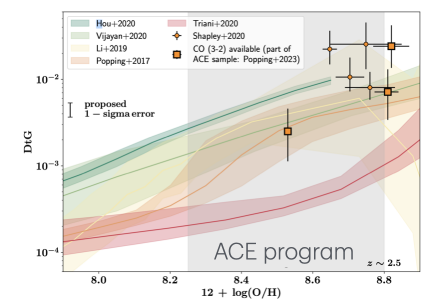Thesis topic: The dust properties of sub-solar metallicity galaxies at cosmic noon
Thesis Supervisor: Gergö Popping
Abstract
The redshift range of z ∼ 1 − 3, dubbed Cosmic Noon, is the peak epoch of star formation and black hole activity in the Universe and an important epoch for the cosmic cycle of baryons in and out of galaxies, a complex and multi-phase process at the core of galaxy formation and evolution. During this epoch, vast quantities of gas were accreted onto galaxies from the cosmic web, which cooled, condensed, and collapsed to form stars, which then enriched the ISM. The ISM conditions are known to be significantly different at z ∼ 2 compared to z ∼ 0, making local galaxies unsuitable for understanding the baryon cycle at this key epoch. Yet, there are still no combined observations of the fuel for star formation (molecular gas), star formation rate (SFR), and gas-phase and solid-phase metals (metallicity and dust) in the typical population of star-forming galaxies at Cosmic Noon. The recently approved large program 'ALMA Chemical Evolution (ACE) survey' will change this picture by constraining the gas and dust mass, respectively, for a representative sample of 25 star-forming galaxies at z = 2.0 − 2.5 that cover a wide, so-far unexplored, range in stellar mass, metallicity and star-formation rate. ACE will link metals in gas-phase to those locked up in dust grains to constrain the buildup of dust and will reveal the fundamental role of molecular gas reservoirs in shaping the mass-metallicity relation, for the first time in a range of galaxies at Cosmic Noon.
The proposed PhD thesis will focus on characterising the dust properties of Cosmic Noon galaxies across a so far unexplored stellar mass, SFR and metallicity range and put this in the context of the wide range of currently unconstrained galaxy formation models that provide dust predictions. This will be achieved by leveraging data from the ALMA Chemical Evolution survey, combined with data from ground and space based observatories such as JWST, the VLT and Keck.

Figure 1: The dust-to-gas ratio of galaxies as a function of their metallicity. Over the last decade theoretical models (solid lines) have started to provide predictions for the dust properties of Cosmic Noon galaxies at sub-solar metallicities, which are mostly unconstrained by observations (orange points). The successful candidate will be working on the ACE program, which is designed to provide the first statistical observational counterpart to these predictions and test these models.
Papers of interest:

